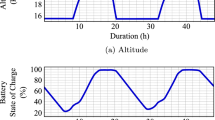Abstract
During the preliminary design of space transportation systems, the vehicle dynamics are commonly reduced to a point-mass model for definition of the flight trajectory. While this approach effectively reduces the number of model parameters in the design process, it neglects the rotational dynamics of the vessel completely. Since the rotational degrees of freedom (DOF) have a significant influence on the vehicle’s controllability, a sole analysis of the translational dynamics is insufficient to assess the general feasibility of the concept. This study investigates the ascent flight trajectory of the SpaceLiner vehicle, a concept for a hypersonic suborbital space plane, based on a newly developed 6-DOF flight dynamics simulation to determine the influence of the rotational dynamics on the vehicle’s controllability and performance. The first part of this paper will focus on the developed vehicle model which features a transient inertia model, as well as an algorithmic-designed flight control system. The second part will present several simulations of nominal and off-nominal ascent trajectories. Based on the results it will be shown that SpaceLiner’s thrust vector control system is sufficiently dimensioned for the investigated mission scenarios, while the vehicle performance is only slightly influenced by the rotational dynamics.























Similar content being viewed by others
References
Sippel, M., Klevanski, J., Steelant, J.: Comparative Study on Options for High-Speed Intercontinental Passenger Transports: Air-Breathing- vs. Rocket-Propelled. In: IAC-05-D2.4.09, 56th International Astronautical Congress, Fuduoka (2005)
Sippel, M., Foreest, A.: SpaceLiner Rocket-Powered High-Speed Passenger Transportation Concept Evolving in FAST20XX. In: IAC-10-D2.4.06, 61st International Astronautical Congress, Prague (2010)
Sippel, M., Schwanekamp, T., Trivailo, O., Kopp, A., Bauer, C., Garbers, N.: SpaceLiner Technical Progress and Mission Definition. In: AIAA 2015–3582, 20th AIAA International Space Planes and Hypersonic Systems and Technologies Conference, Glasgow (2015)
Sippel, M., Schwanekamp, T., Ortelt, M.: Staged Combustion Cycle Rocket Engine Subsystem Definition for Future Advanced Passenger Transport. Space Propulsion, No. 30, Cologne (2014)
Schwanekamp, T., Ludwig, C., Sippel, M.: Cryogenic Propellant Tank and Feedline Design Studies in the Framework of the CHATT Project. In: AIAA 2014–2370, 19th AIAA International Space Planes and Hypersonic Systems and Technologies Conference, Atlanta (2014)
Valluchi, C., Sippel, M.: Hypersonic Morphing for the SpaceLiner Cabin Escape System. In: 7th European Conference for Aeronautics and Space Science EUCASS, Milan (2017)
Sippel, M., Schwanekamp, T., Bauer, C., Garbers, N., van Foreest, A., Tengzelius, U., Lentsch, A.: Technical Maturation of the SpaceLiner Concept. In: AIAA 2012–5850, 18th AIAA International Space Planes and Hypersonic Systems and Technologies Conference, Tours (2012)
Sippel, M., Bussler, L., Kopp, A., Krummen, S., Valluchi, C., Wilken, J., Prévereaud, Y., Vérant, J.-L., Laroche, E., Sourgen, F., Bonetti, D.: Advanced Simulations of Reusable Hypersonic Rocket-Powered Stages. In: AIAA 2017–2170, 21st AIAA International Space Planes and Hypersonic Systems and Technologies Conference, Xiamen (2017)
Sippel, M., Trivailo, O., Bussler, L., Lipp, S., Valluchi, C., Kaltenhäuser, S., Molina, R.: Evolution of the SpaceLiner towards a Reusable TSTO-Launcher. In: IAC-16-D2.4.03, 67th International Astronautical Congress, Guadalajara (2016)
Krummen, S.: Investigation of flight dynamics and effects of rotational degrees of freedom on the flight performance of asymmetric space transportation systems based on the SpaceLiner 7 concept. In: SART TN-010/2016, Bremen (2016)
The MathWorks Inc.: Product Documentation. https://www.mathworks.com/help/index.html (2018). Accessed 16 Feb 2018
Wilken, J., Bussler, L.: SpaceLiner System Specification Document, SL-SS-SART-00026-1/0, Bremen (2017)
Schwanekamp, T., Morsa, L., Zuppardi, G., Molina, R.: SpaceLiner 7-2 Aerodynamic Reference Database. SART TN-026/2012, Bremen (2012)
Rosema, C., Doyle, J., Auman, L., Underwood, M., Blake, W.: Missle Datcom: User’s Manual—2011 Revision. AFRL-RB-WP-TR-2011-3071, Ohio (2011)
Casali, E., Bussler, L., Sippel, M.: Investigation of feasible flight trajectories and re-entry atmospheric guidance for SpaceLiner 7. SART TN-014/2015, Bremen (2015)
Brockhaus, R., Alles, W., Luckner, R.: Flugregelung, 3rd edn. Springer, Heidelberg (2011)
Aström, K., Hägglund, T.: Automatic tuning of simple regulators with specification on phase and amplitude margins. Automatica 20(5), 645–651 (1984)
Yu, C.-C.: Autotuning of PID Controllers. A Relay Feedback Approach, 2nd edn. Springer, Heidelberg (2006)
Wilson, D.I.: Relay-based PID tuning. Autom. Control 2005, 10–11 (2005)
Zipfel, P.H.: Modeling and Simulation of Aerospace Vehicle Dynamics. American Institute of Aeronautics and Astronautics, Reston (2007)
U.S. Department of Defense: World Geodetic System 1984, NIMA TR8350.2, 3rd edn (2000)
National Aeronautics and Space Administration: U.S. Standard Atmosphere 1976. NASA-TM-X-74335, Washington (1976)
Hedin, A.E., Fleming, E.L., Manson, A.H., Scmidlin, F.J., Avery, S.K., Clark, R.R., Franke, S.J., Fraser, G.J., Tsunda, T., Vial, F., Vincent, R.A.: Empirical wind model for the upper, middle and lower atmosphere. J. Atmos. Terr. Phys. 58(13), 1421–1447 (1996)
U.S. Department of Defense: Flying Qualities of Piloted Aircraft. MIL-HDBK-1797 (1997)
Trivailo, O., Sippel, M., Valluchi, C., Lipp, S., Bussler, L., Kopp, A., David, E.: SpaceLiner Mission Requirements Document. SL-MR-SART-00001-1/2, SART TM-005/2016, Bremen (2016)
Dumoulin, J.: NSTS 1988 News Reference Manual. http://science.ksc.nasa.gov/shuttle/technology/sts-newsref/stsref-toc.html#sts-mps (2000). Accessed 20 Aug 2017
Author information
Authors and Affiliations
Corresponding author
Rights and permissions
About this article
Cite this article
Krummen, S., Sippel, M. Effects of the rotational vehicle dynamics on the ascent flight trajectory of the SpaceLiner concept. CEAS Space J 11, 161–172 (2019). https://doi.org/10.1007/s12567-018-0223-7
Received:
Revised:
Accepted:
Published:
Issue Date:
DOI: https://doi.org/10.1007/s12567-018-0223-7




